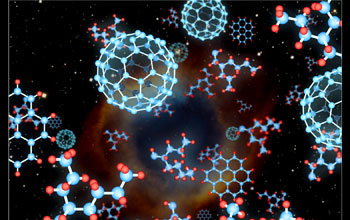Multimedia Gallery
Buckyballs Discovered in Another Galaxy
Artist's representation showing some forms of carbon compounds (foreground) against a depiction of a planetary nebula similar to the one detected in another galaxy called the Small Magellanic Cloud. Each pattern of carbon atoms has its own properties and its own infrared signature. Like diamonds, buckyballs are extremely strong and durable.
More about this Image
Astronomers using NASA's Spitzer Space Telescope have detected for the first time, arrangements of carbon atoms known as buckyballs outside of the Miliky Way galaxy. The discovery of buckyballs in the Small Magellanic Cloud--a dwarf galaxy containing several hundred million stars--suggests that these complex molecules may be present around many stars, where it was predicted they would be unlikely to form.
Using the Spitzer's infrared spectrometer instrument, dozens of planetary nebulae that were known to have hydrogen-rich shells of gas, ejected from a dying star, were searched. The ejected material contained carbon grains (much like soot) that condensed further from the star. In this cooling process--and under exposure to ultraviolet radiation--the grains not only can form fullerenes, but other carbon molecules called polycyclic aromatic hydrocarbons (PAHs)--that can be created on Earth in the exhaust of diesel engines. The four, fullerene-rich planetary nebulae detected are within reach of the National Optical Astronomy Observatory's (NOAO) telescopes for follow-up spectroscopy, as well as the large sample of planetary nebulae that was searched for fullerene. Meticulous follow-up is forthcoming to determine the temperature and composition of their hot gas flows, with the aim of determining the physical and evolutionary characteristics of the fullerene-rich objects compared to the general planetary nebula population.
NOAO is a national center for research on ground-based optical and infrared astronomy supported by the National Science Foundation. To learn more about this discovery, see the NOAO news release "Buckyballs Discovered in Another Galaxy." (Date of Image: October 2010)
Credit: Pete Marenfeld (NOAO)
See other images like this on your iPhone or iPad download NSF Science Zone on the Apple App Store.
Images and other media in the National Science Foundation Multimedia Gallery are available for use in print and electronic material by NSF employees, members of the media, university staff, teachers and the general public. All media in the gallery are intended for personal, educational and nonprofit/non-commercial use only.
Images credited to the National Science Foundation, a federal agency, are in the public domain. The images were created by employees of the United States Government as part of their official duties or prepared by contractors as "works for hire" for NSF. You may freely use NSF-credited images and, at your discretion, credit NSF with a "Courtesy: National Science Foundation" notation.
Additional information about general usage can be found in Conditions.
Also Available:
Download the high-resolution JPG version of the image. (494 KB)
Use your mouse to right-click (Mac users may need to Ctrl-click) the link above and choose the option that will save the file or target to your computer.

